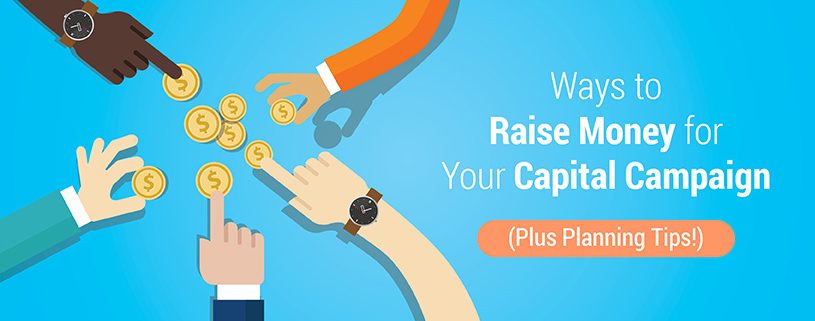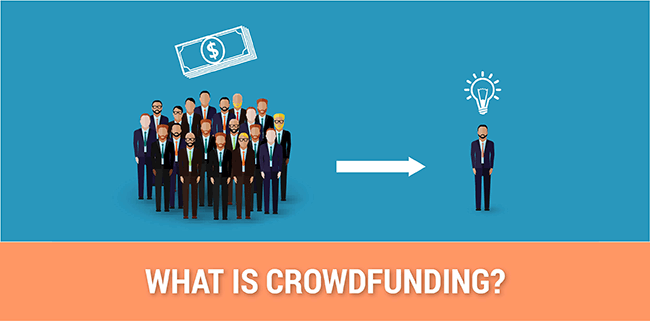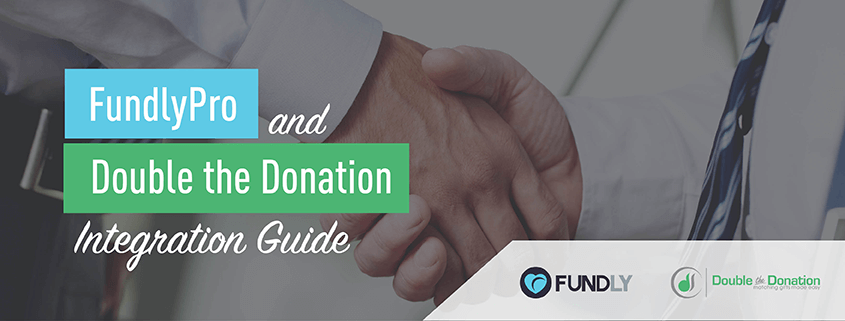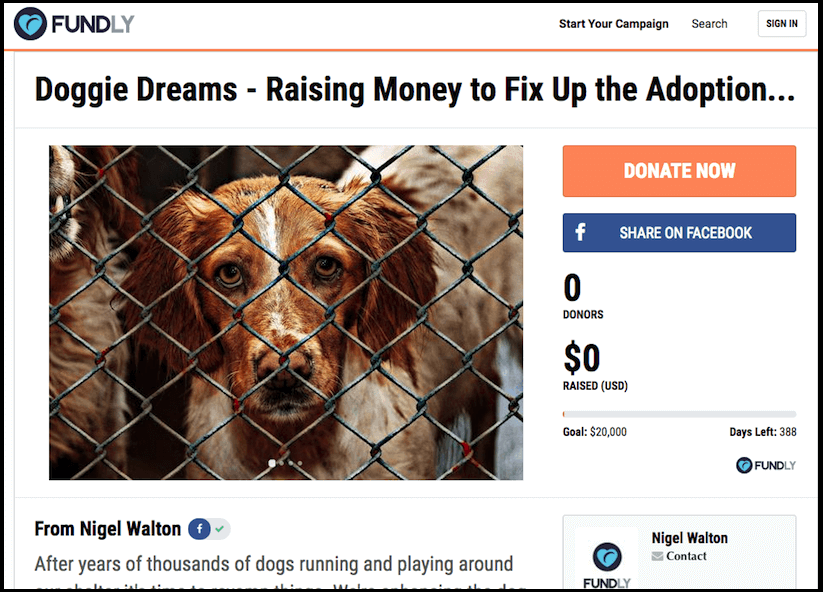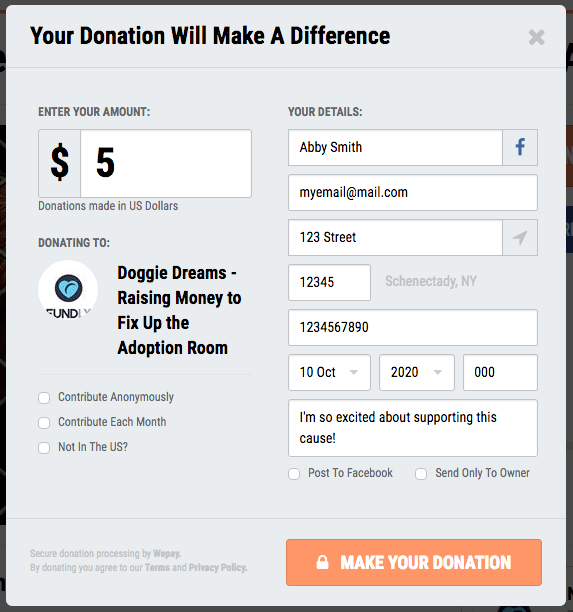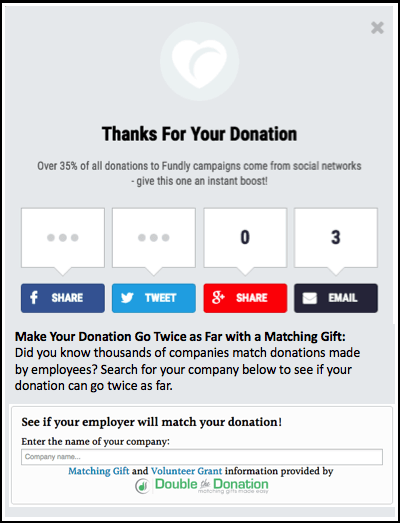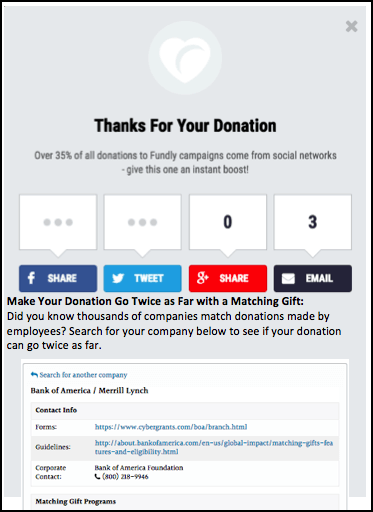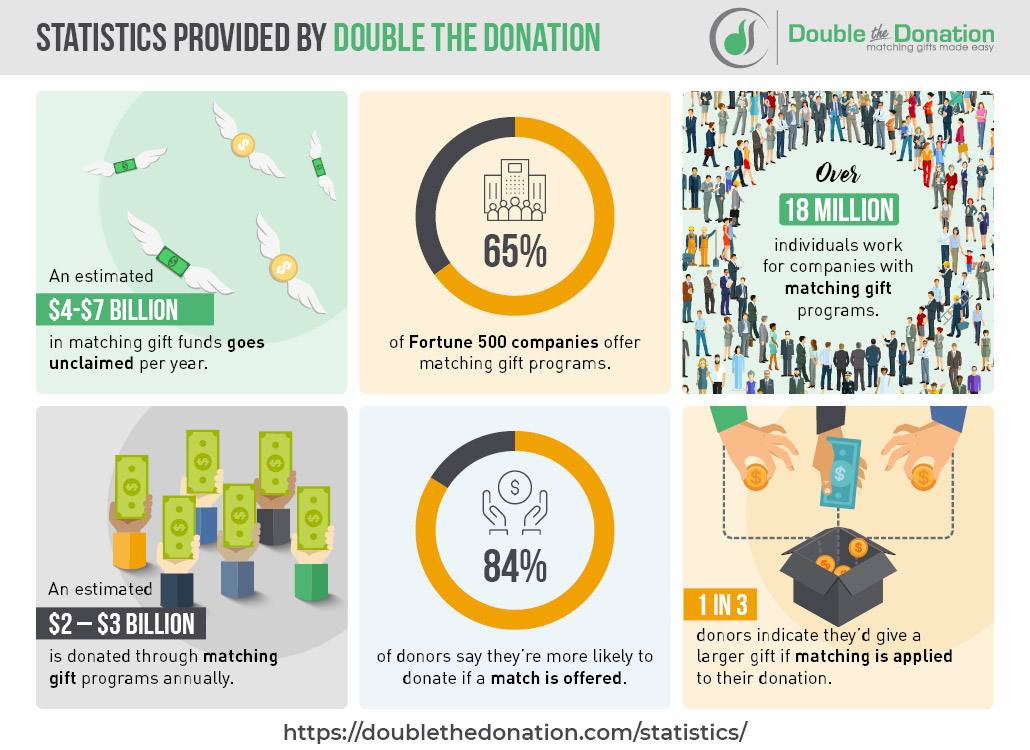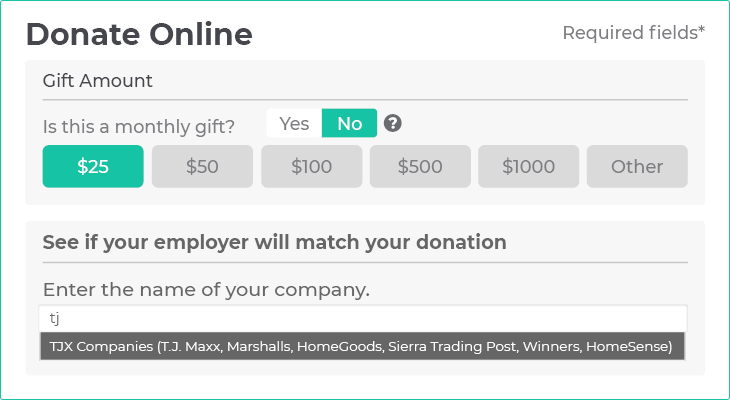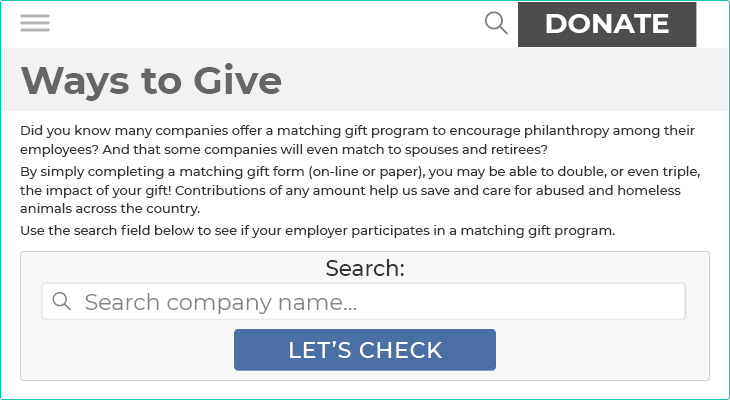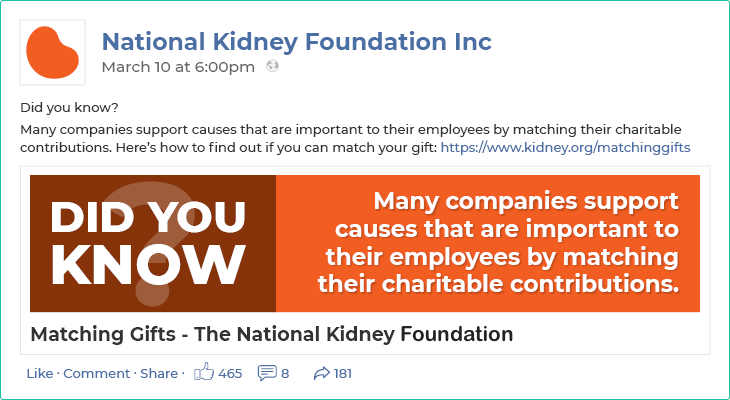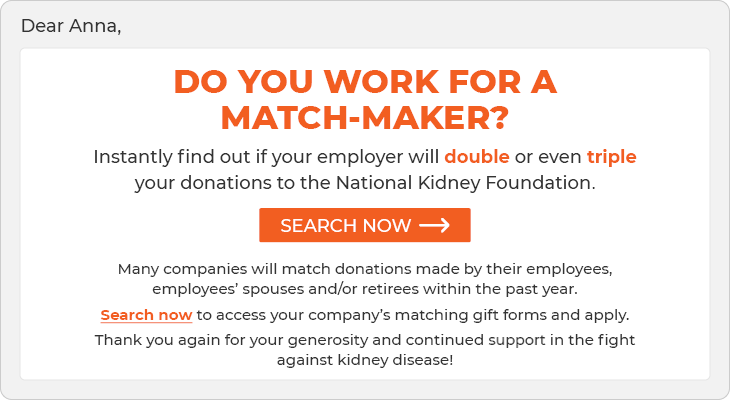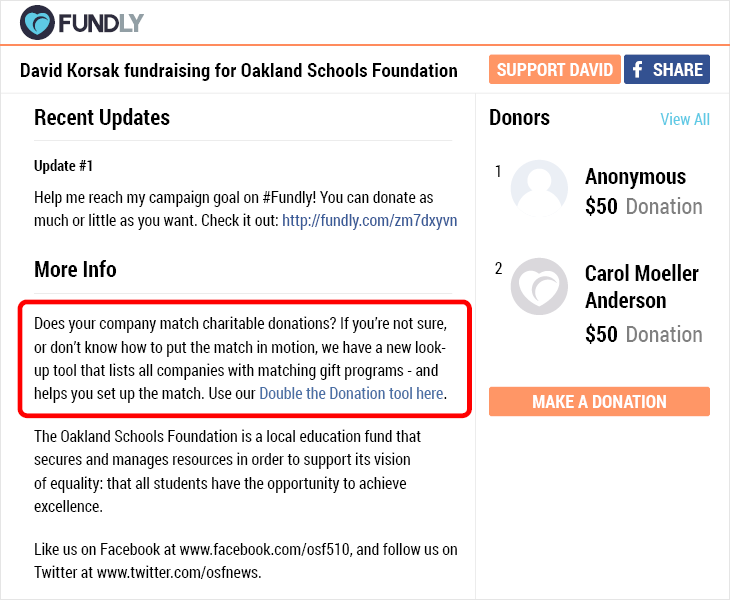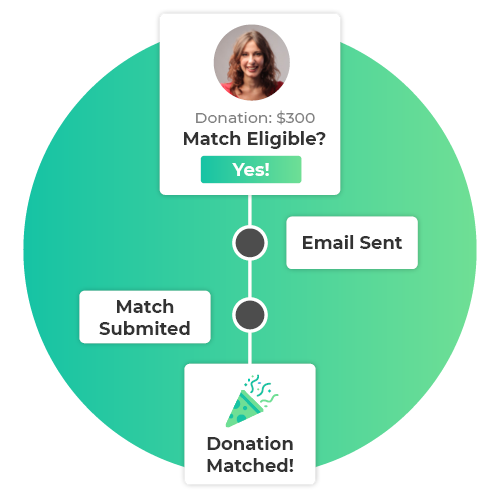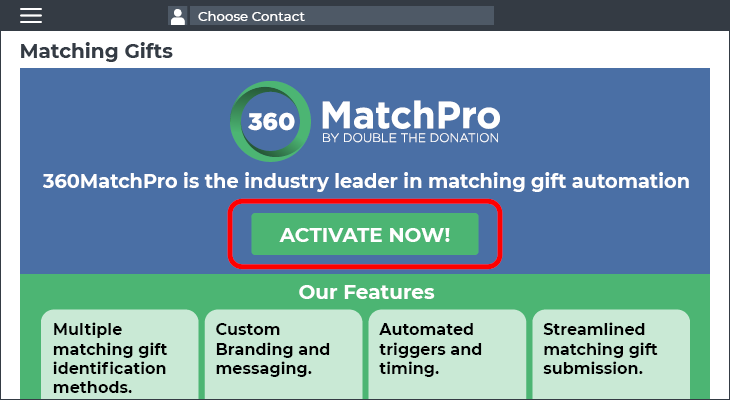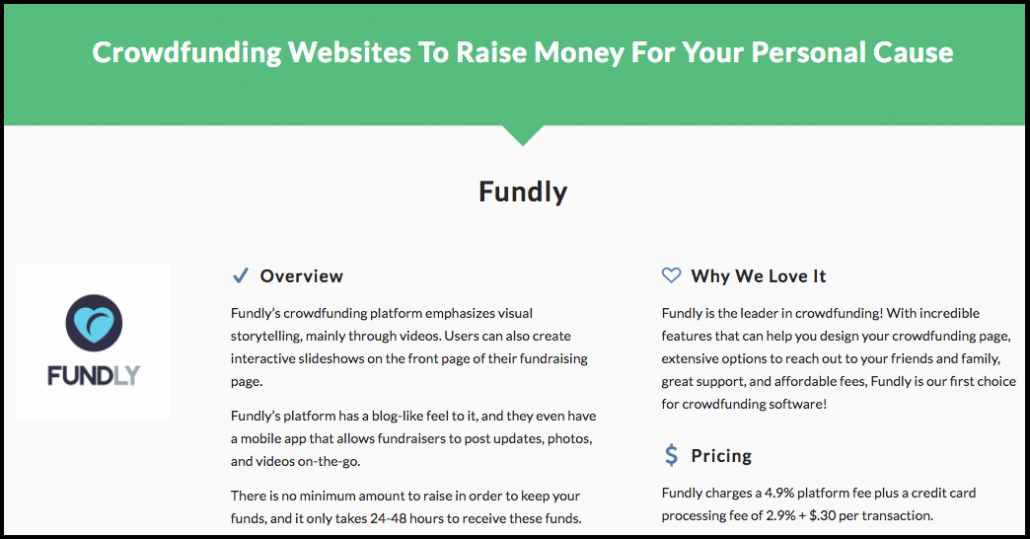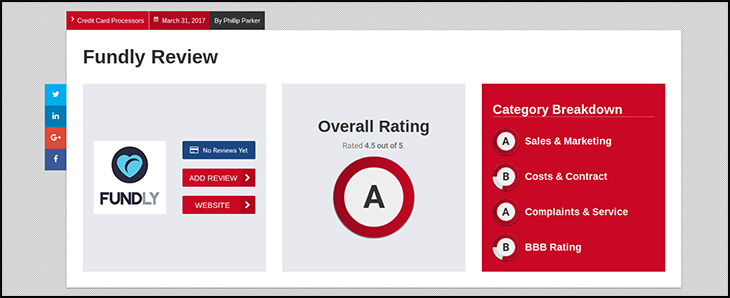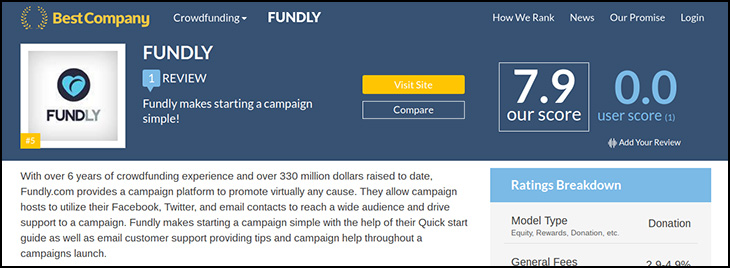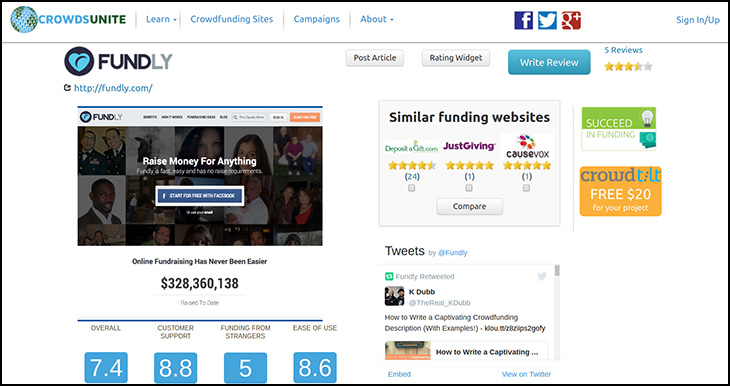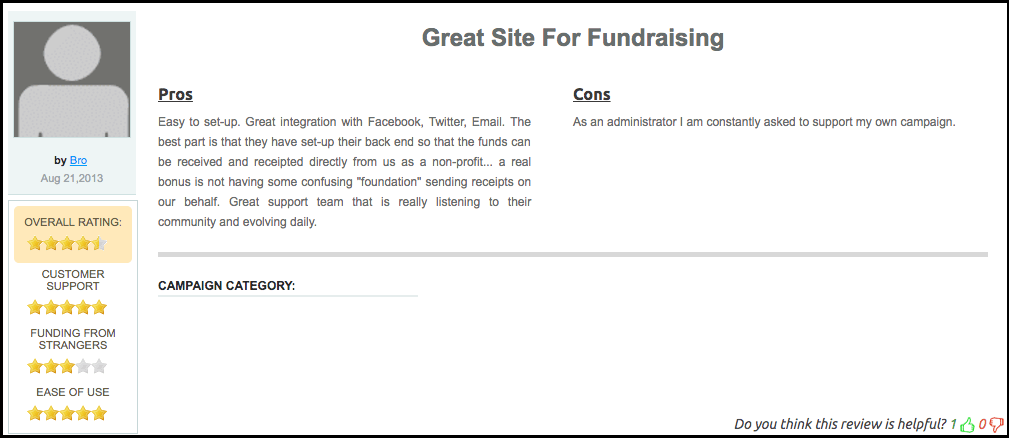FundlyPro and Double the Donation Integration Guide
by Kate WhiteDoes your nonprofit use FundlyPro? Do you want to potentially receive twice as many donations during your crowdfunding campaign?
If so, keep reading! FundlyPro has integrated with Double the Donation, the leading matching gift software provider.
This integration enables nonprofits to promote matching gifts to their supporters after a donation has been made.
Let’s run through what the process will look like for your donors.
First, a donor will arrive on your FundlyPro donation page.
Once they click on “Donate Now,” the FundlyPro donation page will appear. Donors will input their personal and credit card information.
Once the donor clicks “Make Your Donation,” they will see a confirmation page. This is where the donor will be able to use Double the Donation’s matching gift search tool.
In this example, our donor works at Bank of America. When they start typing in their employer’s name, they will see matching gift information that is specific to that company.
Donors can learn more about their company’s matching gift program including information about:
- Forms
- Guidelines
- Contact information
- Minimum and maximum match amounts
- Match ratios
- Employee eligibility
- Nonprofit eligibility
- Deadlines
- Submission processes
- And more!
FundlyPro’s integration with Double the Donation makes it easier for your donors to research their employer’s matching gift program and complete the necessary steps to submit match requests.
This means that your nonprofit could potentially raise twice as much during your crowdfunding campaign’s duration!
If you haven’t set up a FundlyPro account yet, you can do so here.
For more information about Double the Donation’s services, click here.
Matching Gifts: Your Secret Weapon for Fundraising Success
by Kate WhiteMatching gifts are corporate giving programs in which companies match employee donations to eligible nonprofits. Depending on the company, gifts can be doubled, tripled, or even quadrupled!
Companies both big and small offer these programs. In fact, 65% of Fortune 500 companies engage in corporate giving. However, the median employee participation rate is just 9% due to a general lack of awareness about available opportunities. This leads to nonprofits losing free money.
As Fundly President Lomesh Shah puts it,
Matching gifts are the fundraising buried treasure that nonprofits need. Matching gifts are out there and can do wonders for an organization. However, most donors don’t have a map to the gold.
Fundly has the map that your nonprofit needs! We’ll teach you how to set donors along the dotted path to matching gifts, so they’ll submit more match requests and supply your nonprofit with more money. Here’s what we’ll cover:
- The Matching Gift Process
- Ratios, Limits, Eligibility, and Deadlines
- Who to Promote Matching Gifts to
- How to Promote Matching Gifts
- Top Companies with Matching Gift Programs
- Top Matching Gift Software and Databases
- NonProfitEasy Matching Gift Integration
- FundlyPro and Double the Donation Integration Guide
Nonprofits everywhere have made matching gifts a regular part of their fundraising. Discover how you can do the same!
THE MATCHING GIFT PROCESS
Acquiring corporate matching gifts is fairly straightforward. While each company has its own rules, you can expect the process to follow the same general framework.
1. A DONOR MAKES A CONTRIBUTION
The process begins when an employee decides to make a charitable donation to a nonprofit organization. This donation can be in the form of cash, check, or online payment.
2. A DONOR CHECKS THEIR MATCHING GIFT ELIGIBILITY
After making their charitable contribution, the donor needs to verify that their employer has a matching gift program. If the nonprofit uses matching gift software, the donor can check their eligibility using a search feature on the donation page. With this tool, they can enter their company’s name and instantly receive:
- Eligibility guidelines
- Minimum and maximum amounts eligible for matching
- Available request forms and submission deadlines
If the nonprofit lacks matching gift software, the donor can inquire through their company website, corporate social responsibility (CSR) department, or HR team.
3. A DONOR SUBMITS A MATCHING GIFT REQUEST
If the employer has a matching gift program and the donation is eligible, the donor can initiate a matching gift request. In most cases, they will need to navigate to their company’s designated CSR platform and fill out relevant information, such as the donation amount, nonprofit tax ID, mailing address, and payment method.
4. THE COMPANY REVIEWS THE DONATION
The company reviews the matching gift request to ensure it meets the program’s requirements, verify the employee’s eligibility, and check the nonprofit’s tax-exempt status. Once approved, the employer commits to matching the employee’s donation using the predetermined matching ratio. This is typically dollar-for-dollar, which means they’ll contribute the same amount as the initial donation.
5. THE MATCHING GIFT IS PROCESSED
After approval, the employer processes the match, either through a check or an electronic transfer of funds. In turn, the nonprofit receives both the original donation from the employee and the matching gift from the employer.
HOW SOFTWARE IMPACTS THE PROCESS
Keep in mind that certain software providers offer tools to make this process even simpler, such as:
- Matching gift databases. This tool houses information on companies’ corporate giving programs. You can research your donors’ employers to determine their eligibility or have your supporters do so themselves. You’ll just need to use matching gift software to embed a company search tool on your donation form or confirmation page.
- Matching gift auto-submission. When a donation is made, this software automatically identifies the employee’s eligibility and initiates the matching gift request without requiring manual input. This saves employees time and ensures that potential matching opportunities are accounted for!
To locate as many eligible matches as possible, choose a matching gift solution that integrates with popular employee giving software. Doing so will streamline the matching gift process, enable auto-submission, and result in a more efficient experience for donors, nonprofits, and companies.
Matching Gift Statistics
- Approximately 18 million individuals work for companies with matching gift programs.
- An estimated $4-$7 billion in matching gift funds goes unclaimed each year.
- The average employee participation rate in their employer’s matching gift program is 9%.
- 12.3% of total corporate giving goes toward matching gifts.
RATIOS, LIMITS, ELIGIBILITY, AND DEADLINES
Companies set guidelines to ensure they’re making a difference through corporate philanthropy without blowing their budgets. Let’s explore common stipulations that nonprofits and donors should know.
MATCHING GIFT RATIOS
Most companies do a standard 1 for 1 match. This means that an employee’s donation is simply doubled.
However, many businesses choose to go above and beyond and match donations at a 2:1 or even 3:1 ratio, tripling or quadrupling donations!
Other companies will match donations at different ratios depending on the donor’s employment status.
For example, Johnson & Johnson matches full- and part-time employees’ donations at a 2:1 ratio, but they match retirees’ donations at a standard 1:1 ratio.
MATCHING GIFT LIMITS
Unfortunately, companies don’t have endless money to distribute to nonprofits via matched donations.
Many businesses have an employee cap or limit that resets every year. The company will match individual employee donations up to that cap.
Additionally, most corporations have a minimum donation amount that must be met before they match.
This minimum is usually between $25 and $50, but some companies (like Apple) will match contributions as low as a single dollar!
MATCHING GIFT ELIGIBILITY
Many companies will match donations to nearly any nonprofit or cause, but some have a few restrictions.
In order to be eligible, a nonprofit organization might have to do work that falls in line with the company’s core philanthropic missions.
For instance, State Farm Insurance only matches donations to schools, universities, and educational nonprofits.
The employee’s donation must also be eligible. The majority of companies will only match cash donations, not in-kind contributions.
MATCHING GIFT DEADLINES
Most companies will only match employee donations if they are made in a certain timeframe.
In many cases, the business will match an employee’s donation if it was made within the last calendar year or the last six months.
However, other companies have more relaxed timelines and will allow employees to submit requests a bit later.
For example, GE’s deadline for matching gift submissions is April 15th of the year following the donation date. This gives employees tons of time!
WHO SHOULD YOUR NONPROFIT PROMOTE MATCHING GIFTS TO?
Remember, lack of awareness is one of the main reasons nonprofits miss out on matching gifts. Make sure you market these opportunities to the right audiences to secure more corporate matches and maximize revenue.
CURRENT DONORS
Your current supporters are the ones who care the most about your cause. Whether they give once a year or once a week, they all want to see your nonprofit achieve your goals.
These people are the perfect demographic for matching gift promotion because of their dedication to your organization and your cause.
You can use emails, social media, direct mail, and your donation process to market matching gifts to your current donors at any time of the year.
And depending on matching-gift-request submission deadlines, you may be able to look months back to past donors and encourage them to submit their requests as well.
SMALL, LOCAL COMPANIES
Most people think of big corporations matching millions of dollars a year in donations, but your nonprofit can encourage local businesses to start their own matching gift programs!
If you have connections with a local company – big or small – reach out to the owner or CEO to talk about how they can implement a matching gift program.
There are even businesses that can help small, local companies design, implement, and manage their corporate giving programs. The list includes: Good Done Great, YourCause, CauseCast, and Benevity.
It’s an out-of-the-box way to promote matching gifts to people in your community and help local businesses get started with their own corporate philanthropy programs.
EVENT PARTICIPANTS
Some companies take matching gift programs one step further: they’ll match any money that an employee raises for a fundraising walk, run, or cycling event.
If you host an annual walkathon, marathon, or other active event, make sure that your participants are aware of fundraising match programs.
While these programs aren’t as common as standard matching gift programs, they can give your nonprofit an extra fundraising boost during one of your fundraising events!
PROSPECTS
It might seem counterproductive to promote matching gifts to people before they’ve donated, but doing so can be a boon for your campaign.
Donation response rates increase by 71% when matching gifts are mentioned in fundraising appeals, and the average donation amount jumps up by 51%.
If you’re trying to convince people to give to your nonprofit, letting them know about matching gifts can be the extra little push they need to make a contribution.
HOW SHOULD YOUR NONPROFIT PROMOTE MATCHING GIFTS?
Now that you know who to market matching gifts to, you need to determine how you’ll do so. Let’s explore a few popular ways to promote corporate giving to relevant stakeholders.
Promote Matching Gifts on Your Donation Page
HOW TO PROMOTE MATCHING GIFTS ON YOUR DONATION PAGE
It’s easy to promote matching gifts on your donation page!
All you need to do is:
- Include a sentence or two about the importance of matching gifts.
- Use a matching gift tool that allows donors to look up their company’s program.
- Include a field or checkbox for donors to indicate that their gift will be matched.
You can place this information anywhere on your donation form, but it’s best to include it at the top so that it’s the first thing that donors see!
WHY IT WORKS
Donors are most invested when they’re in the middle of the giving process. They clearly care about your organization and want to help you accomplish your mission and pursue your cause.
That’s why it makes so much sense to promote matching gifts on your donation page.
If donors know that they might be able to give twice as much without opening their wallets a second time, they are more inclined to look into their employer’s matching gift program right then and there.
Matching gift promotion on a donation page is the #1 way to capture more matched donations from your donors’ employers.
Promote Matching Gifts Across Your Website
HOW TO PROMOTE MATCHING GIFTS ACROSS YOUR WEBSITE
Your nonprofit’s website is your online hub. It’s where people can go to learn more about your mission and discover ways that they can get involved with your cause. It also happens to be the perfect place to promote matching gifts!
Depending on your website’s set-up, you might find that some pages are better suited for matching gift promotion. You can include matching gift information:
- In your navigation.
- On your “Ways to Give” page
- On a dedicated matching gifts page.
Make sure you explain matching gifts, how they help your organization, and how donors should submit requests. You can also include a matching gift tool for easy company lookup!
WHY IT WORKS
Your website is the most authoritative source for people who are looking for information on your nonprofit and the ways they can give to your cause.
When you use your website to promote matching gifts to your donors, you keep the information fresh in their minds whenever they research your nonprofit or look for ways to give to your mission.
The more that donors are aware of matching gifts, the more likely they’ll be to submit matching gift requests to their employers.
Promote Matching Gifts via Social Media
HOW TO PROMOTE MATCHING GIFTS VIA SOCIAL MEDIA
Your organization is likely posting, tweeting, liking, or commenting on some form of social media. Why not use one or more of those platforms to advertise matching gifts?
The key to promoting matching gifts on social media is to keep the message short and sweet. Sites like Facebook, Twitter, and Instagram don’t give people much space to go in-depth.
Instead, give a short teaser about matching gifts and then link out to more information (like a dedicated matching gifts page!) that will give donors more detailed instructions about matching gift submission.
WHY IT WORKS
Facebook has over 1.5 billion users. Instagram has 400 million active users. Twitter boasts nearly 330 million users.
These numbers can’t be ignored! Your donors are using social media on a regular basis, and many of them follow your nonprofit looking for updates about your cause and ways they can get involved.
Promoting matching gifts on social media means that you can spread the word about matching gift programs to multiple people at one time. It’s the quickest way to let your donors know that they might be able to double their donations to your organization!
Promote Matching Gifts with Email Newsletters
HOW TO PROMOTE MATCHING GIFTS WITH EMAIL NEWSLETTERS
Your nonprofit likely sends out a newsletter at least once a month. You may send them out less frequently than that, but you should be sending out some kind of email communication on a regular basis.
These email newsletters are the optimal way to let donors know about matching gifts.
Newsletters allow your nonprofit to talk about matching gifts in a bit more detail than you’d be able to in a social media post.
You can mention matching gifts in a more comprehensive newsletter, or you can choose to dedicate an entire newsletter to matching gifts and how donors can submit their requests.
Either way you go, make sure that you include a link to a page where donors can find more information about matching gifts.
WHY IT WORKS
Many of your dedicated supporters sign up for your email newsletter because they are invested in your nonprofit and your cause. They want to stay in the loop, and an email newsletter helps them do that with minimal effort on their part.
Since your most invested donors are likely the people reading your email newsletter, they are also the individuals who are the most likely to submit a matching gift request to their employer and go the extra mile for your organization.
And if you provide a link to more information, donors might even submit a matching gift request right then and there!
Promote Matching Gifts During Your Crowdfunding Campaign
HOW TO PROMOTE MATCHING GIFTS DURING YOUR CROWDFUNDING CAMPAIGN
If your nonprofit has started a crowdfunding campaign, you can use your campaign page to promote matching gifts to donors and people that come across your fundraiser.
You can place information about matching gifts in your crowdfunding description and include a link to more information.
Additionally, if you set up a crowdfunding campaign with Fundly, you can integrate Double the Donation’s matching gift tool. This integration allows donors to look up their company’s matching gift program without even having to leave your fundraising page!
WHY IT WORKS
Crowdfunding campaigns are very specific fundraising efforts. They have a pre-determined deadline as well as a fundraising goal that needs to be met.
This unique combination makes a crowdfunding campaign the perfect place to promote matching gifts to supporters!
The urgency of needing to meet a fundraising goal by a certain date means that donors will be more willing to go the extra mile and have their donations doubled (or even tripled!).
Learn how matching gifts can help your Fundly crowdfunding campaign!
TOP COMPANIES WITH MATCHING GIFT PROGRAMS
The best way to learn how matching gifts work is to look at real-world examples. Luckily, there are plenty of generous companies out there that have corporate matching gift programs you can learn from. Let’s take a look at a few of those.
Apple’s Matching Gift Program
Apple is a top matching gift company that offers a maximum match of $10,000 per employee per year. This applies to full-time and part-time employees at a 1:1 ratio.
Apple will match donations to most nonprofits, including educational institutions, health and human services, arts and cultural organizations, and others. Employees should submit their match request within 1 month of the donation date.
Disney’s Matching Gift Program
Disney offers a generous matching gift program, matching donations anywhere from $25 to $25,000 at a 1:1 ratio. Full- and part-time employees are eligible to request matching donations and should do so online.
Disney will match donations made to a variety of organizations, such as educational institutions, health and human services, and most other nonprofits.
The Home Depot’s Matching Gift Program
The Home Depot offers matching gifts for donation amounts ranging from $25 to $3,000 at a 1:1 ratio. Employees who wish to submit a match request should do so by January 31 of the year following the donation date. This can be done electronically.
Full-time and part-time employees are eligible and can submit match requests for donations to a variety of nonprofits. These include environmental organizations, arts and cultural organizations, civic and community organizations, and others.
Google’s Matching Gift Program
Google will match donations anywhere from $50 to $10,000 for full-time and part-time employees. Their ratio is 1:1, and the company offers matching gift programs for both nonprofits and disaster/international relief as well.
Google also matches funds employees raise for charitable events in which they participate, such as walkathons, bike rides, etc. Employees should submit their match requests by January 31 of the year following the date of the donation.
TOP MATCHING GIFT SOFTWARE AND DATABASES
Leveraging the right tools will empower you to raise more through matching gifts. Matching gift databases and automation software will provide you with the information and tools you need to drive matches to completion.
Double the Donation
Double the Donation’s matching gift software makes it easy for donors to discover their matching gifts eligibility before, during, or after donation.
With this software, small nonprofits can seamlessly embed their matching gift database in giving forms or on their website to help steer donors toward matching their gifts.
Benefits of using Double the Donation include:
- Easy setup. By inserting a simple snippet of code into your website, you can easily add Double the Donation’s matching gift search tool anywhere you’d like. This includes on dedicated matching gift pages or on donation confirmation pages.
- Customization. If you’re so inclined, you can use CSS for more advanced customization options; however, the plugin works well and looks great even without extra customization.
- Increased revenue. By raising awareness around matching gifts by incorporating the matching gift search tool, you can boost your revenue in this area by 20%, 50%, or even 100%.
Looking to learn more about matching gift software like Double the Donation? Check out our matching gift software guide!
360MatchPro
360MatchPro by Double the Donation is the high-end matching gift tool for larger nonprofits and universities that bring in over $10 million per year.
360MatchPro automates the match process, making it easier for your donors to learn about and submit matching gift requests.
Benefits of using 360MatchPro include:
- Identifying otherwise missed opportunities. Using special identification methods, such email addresses or your donor’s employer information, the platform can automatically screen for matching gift eligibility when a donation is made.
- Seamless outreach. Once a donor is identified as match eligible, 360MatchPro will trigger an email to the donor explaining the next steps they can take to submit a match request. Even if they’re ineligible or their eligibility is undetermined, you can customize specific email templates to incorporate that information and suggest appropriate next steps.
- Easy tracking. Track your donors’ matching gift submissions as they go through each stage. Then, you’ll be able to leverage this information in your reporting and when you follow up with them.
With 360MatchPro, your organization is able to drill down into the matching gift data and discover valuable insights about your matching-gift-eligible donors.
NONPROFITEASY MATCHING GIFT INTEGRATION
NonProfitEasy has integrated with 360MatchPro by Double the Donation to offer its users the very best in matching gift tools!
With 360MatchPro, every donation that flows into your NonProfitEasy triggers an automatic email about matching gifts for the donor.
If the donation was made with a corporate email address, the donor is automatically sent their employer’s matching gift information! If the donor didn’t use a corporate email, they are sent a link to find out if their employer offers matching gifts.
NonProfitEasy and 360MatchPro are integrated, making it easy for you to follow up with every donor about matching gifts as well as track the status of your matches.
Donors can use Double the Donation’s easy matching gift search tool to look for their company’s specific matching gift guidelines, requirements, and paperwork.
All your nonprofit has to do is navigate to the Integrations section of NonProfitEasy, select 360MatchPro, and click “Activate”!
Activate 360MatchPro from within your NonProfitEasy account
Learn more about how you can double your donations with NonProfitEasy’s integration with 360MatchPro!
FUNDLYPRO AND DOUBLE THE DONATION INTEGRATION GUIDE
Is your nonprofit thinking about using FundlyPro to raise money for your cause, project, or event?
Do you want to bring in more matching gifts during your crowdfunding campaign?
If the answer to both of those questions is “Yes,” then we have good news for you!
FundlyPro and Double the Donation are integrated, making it easy for you to promote matching gifts to your donors directly on your fundraising page.
Donors can use Double the Donation’s easy matching gift search tool to look for their company’s specific matching gift guidelines, requirements, and paperwork.
All your nonprofit has to do is embed Double the Donation’s tool in your FundlyPro fundraising page. It’s that simple!
Double the Donation’s matching gift tool on a FundlyPro acknowledgement screen
ADDITIONAL MATCHING GIFT AND CROWDFUNDING RESOURCES
Matching gifts can be a reliable source of revenue for your nonprofit. You just need to be proactive about spreading awareness and staying on top of available opportunities. From understanding common company guidelines to simplifying the request process with software, you now have everything you need to fulfill your matching gift potential.
To continue expanding your CSR knowledge, explore these resources:
- Matching Gift Guide. Itching to learn more about promoting, managing, and tracking matching gifts for your nonprofit’s fundraising success? Dive into 360MatchPro’s extensive guide to help you identify eligible matching gift donors and skyrocket matching gift revenue.
- Matching Gift Companies. Did you know some of the most successful businesses around also have the best nonprofit matching gift and volunteer grant programs? Develop your matching gift strategy further by researching top corporate matching gift programs at 360MatchPro!
- Crowdfunding 101. Crowdfunding and matching gifts go hand in hand because donors are motivated to give more by meeting online fundraising goals and deadlines. Discover more ways crowdfunding can elevate your nonprofit’s online fundraising goals with our in-depth guide!
Fundly Reviews [Updated May, 2017]
by Kate WhiteHere at Fundly, we love hearing from our fundraisers and the people who give to their campaigns. If you’re looking for some honest feedback about Fundly’s crowdfunding platform, look no further! Here are the top Fundly reviews taken from top review sites.
Fundly Reviews from Double the Donation
Double the Donation wrote a glowing review of Fundly’s crowdfunding software and included it in their article, “The Best Crowdfunding Websites for Individual Fundraising.” One highlight said:
Fundly is the leader in crowdfunding! With incredible features that can help you design your crowdfunding page, extensive options to reach out to your friends and family, great support, and affordable fees, Fundly is our first choice for crowdfunding software!
Fundly Reviews from Card Payment Options
Card Payment Options gave Fundly an “A” as an overall rating. Fundly scored 4.5 out of 5 in the combined categories of:
- Sales and Marketing
- Costs and Contract
- Complaints and Service
- BBB Rating
According to the main review:
Similar in structure to Kickstarter or Indiegogo, Fundly offers nonprofits the ability to create an online profile and solicit donations directly from a community of donors.
Fundly Reviews from BestCompany.com
BestCompany.com gave Fundly a 7.9 score, with the main review stating that,
Fundly makes starting a campaign simple with the help of their Quick start guide as well as email customer support providing tips and campaign help throughout a campaign’s launch.
Fundly Reviews from CrowdsUnite
CrowdsUnite has multiple reviews from different Fundly users.
CrowdsUnite has aggregated Fundly reviews and given the following scores:
- Overall – 7.4
- Customer Support – 8.8
- Ease of Use 8.9
One user, a man who used Fundly to finance the production of his CD said that Fundly was,
Very easy to use. I’ve told many people about you guys.
Another user that used Fundly to raise money for their nonprofit organization said that Fundly was,
Easy to set up. Great integration with Facebook, Twitter, Email. The best part is that they have set-up their back end so that the funds can be received and receipted directly from us as a non-profit…Great support team that is really listening to their community and evolving daily.
Now that you’ve seen Fundly reviews on these top 4 websites, you’re probably interested in starting your own campaign.
Check out these additional resources to help you get started on the right track to success!
- If you aren’t convinced by these glowing reviews, check out 10 crowdfunding campaigns that exceeded their fundraising goals using Fundly’s platform.
- And for more information about crowdfunding in general, take a look at our Ultimate Guide.
- Looking for more ways to raise funds? Check out our full list of fundraising ideas for virtually every cause, event, or project.

Crowdfunding Resources
Fundraising Resources:
Popular Resources

Fundly is dedicated to providing you with the tools you need to raise money for whatever your cause may be.

